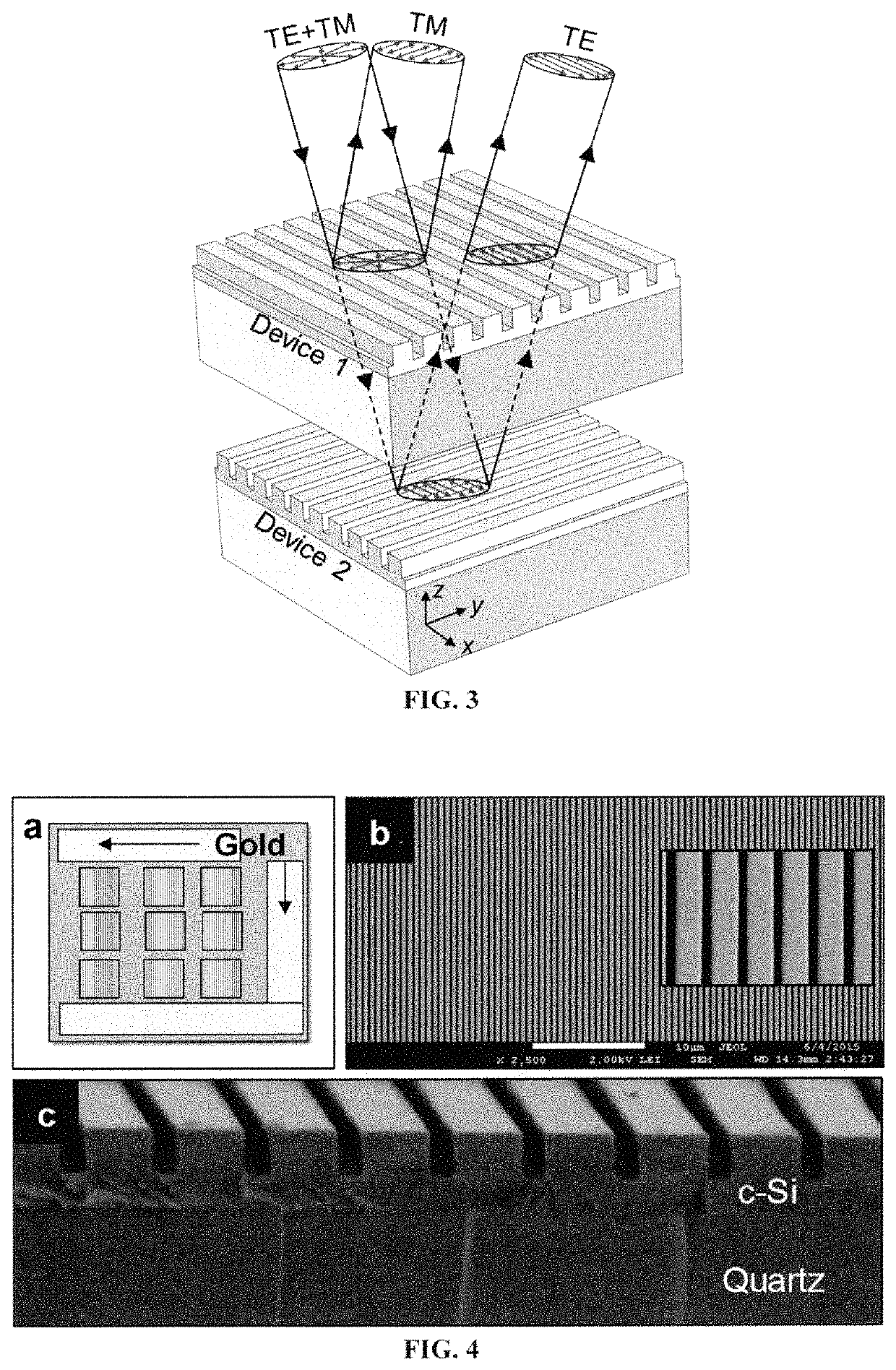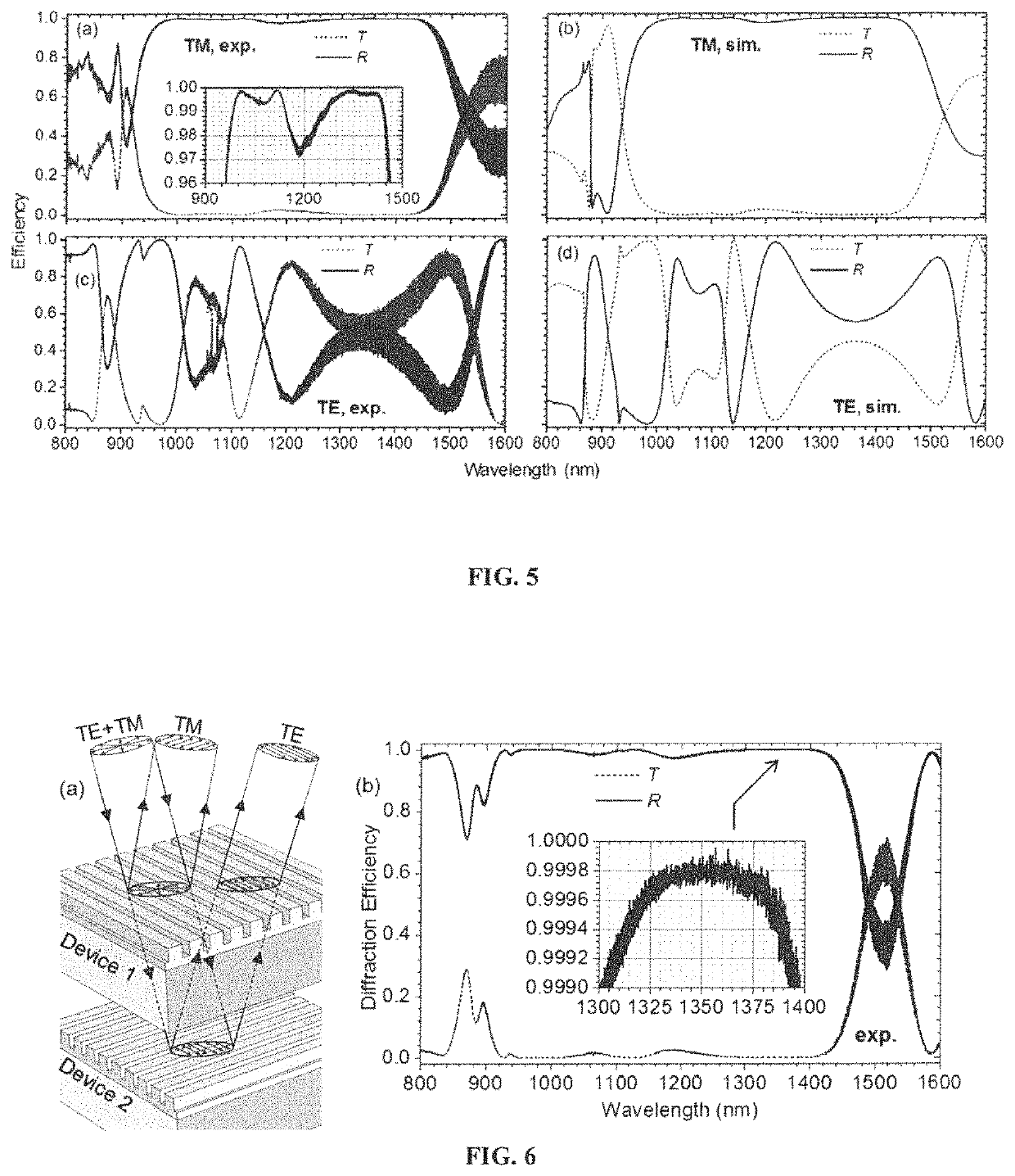Polarization independent wideband reflectors and methods for their manufacture
a wideband reflector and polarization independent technology, applied in the direction of optics, instruments, diffraction gratings, etc., can solve the problems of limited wideband reflection in this one-dimensional (1d) grating architecture, impractical multi-layer deposition, etc., and achieve wide spectral reflection bands, simple design, and robust performance.
- Summary
- Abstract
- Description
- Claims
- Application Information
AI Technical Summary
Benefits of technology
Problems solved by technology
Method used
Image
Examples
example 1
Sequentially Arranged Wideband Reflector Concept
[0038]FIG. 3 illustrates a sequentially arranged wideband reflector schematic. Device 1 and Device 2 are polarization-sensitive wideband reflectors made with zero-contrast gratings (ZCGs) working in TM polarization. When the devices are sequentially arranged such that their grating planes are parallel (x-y plane) and their grating vectors K are orthogonal to one another, wherein K is along the y-axis for Device 1 and the x-axis for Device 2, the overall sequential-arrangement becomes polarization insensitive. For unpolarized input light with TE+TM components, Device 1 near-completely reflects the TM components and partially transmits the TE components. This transmitted TE component is TM polarized with respect to Device 2 and is also completely reflected. This results in near-complete reflection of both TE and TM components resulting in polarization-insensitive wideband reflection. Note that because Device 1 and Device 2 also partially...
example 2
Experimental Demonstration of Unpolarized Wideband Reflectors With Sequential ZCGs
[0039]FIG. 4 depicts SEMs pertinent to a fabricated 1D ZCG broadband mirror. FIG. 4(a) shows a photograph of an array of nine fabricated devices on a 1×1 inch2 SOQ wafer. Each device is 5×5 mm2. Approximately 100-nm-thick gold film is sputtered on the non-device edges of the SOQ wafer. Scanning-electron micrographs showing FIG. 4(b) top-view and FIG. 4(c) cross-sectional images of a representative device. FIG. 5 presents the polarization-dependent spectral response of one of the devices in the array. In particular, FIG. 5(a) shows experimental and FIG. 5(b) simulated zero-order T and R spectra for TM polarized light incidence. FIG. 5(c) furnishes experimental and FIG. 5(d) simulated T and R spectra for TE polarized light incidence. Device parameters are fill factor F=0.63, grating depth dg=330 nm, c-Si film thickness t=520 nm, and grating period Λ=560 nm in both experiment and simulation. Inset in FIG....
example 3
Experimental Reflector Fabricated in Amorphous Silicon-On-Glass
[0040]In a second experimental example, we implement the sequential ZCG arrangement shown in FIG. 3 with a pair of wideband reflectors fabricated in a silicon-on-glass platform as opposed to the previous SOQ example. The two polarization-sensitive reflectors share similar experimental grating parameters that are Λ=856 nm, F=0.54, dg=563 nm, and dh=408 nm. FIG. 8(a) shows an AFM of a representative fabricated device and FIG. 8(b) shows an SEM of a 2×2 array of devices that each measure 5×5 mm2. The reflectors are made with a-Si sputtered onto a substrate of soda-lime glass. FIG. 9(a) reveals the spectral properties of a single prototype a-Si ZCG reflector depicting both numerical and experimental data. There results a wide high-efficiency band for TM polarization extending from λ˜1.7 μm to λ˜2.3 μm. FIG. 9(b) schematically shows the response of the serial reflectors to the two polarization components present in the input ...
PUM
| Property | Measurement | Unit |
|---|---|---|
| air gap distance | aaaaa | aaaaa |
| thick | aaaaa | aaaaa |
| Rayleigh wavelength | aaaaa | aaaaa |
Abstract
Description
Claims
Application Information
 Login to View More
Login to View More - R&D
- Intellectual Property
- Life Sciences
- Materials
- Tech Scout
- Unparalleled Data Quality
- Higher Quality Content
- 60% Fewer Hallucinations
Browse by: Latest US Patents, China's latest patents, Technical Efficacy Thesaurus, Application Domain, Technology Topic, Popular Technical Reports.
© 2025 PatSnap. All rights reserved.Legal|Privacy policy|Modern Slavery Act Transparency Statement|Sitemap|About US| Contact US: help@patsnap.com



